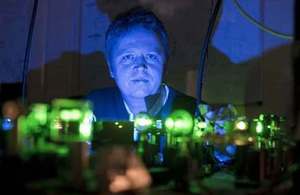Low-cost hologram technology coming to a street corner near you
Creative industries: Smart funding helps Scottish startup to paint a bigger, brighter picture

Ceres Imaging CEO Dr Ian Redmond: 'Smart has been great - we wouldn’t be where we are without it."
A tech startup in Scotland may be about to revolutionise the world of advertising and other markets too with an innovation that produces some of the highest quality, display-sized holograms.
Creating 3D holographic images at a quality and cost suitable for poster advertising and other large-scale applications has long been an elusive goal for researchers. But that is what Dr Ian Redmond set out to do when he founded Ceres Imaging in 2007.
From Ceres Imaging’s base at St Andrews on the Fife coast, CEO Ian said:
I’ve always thought: ‘Why aren’t display holograms better?’ Everyone has a mental image of what they could look like but, to date, the reality is disappointing.
He had an idea for a high-performance holographic printer that could replicate an A4-size hologram in around one minute, as opposed to the 24 hours or more currently needed for a high-quality master. But Ian knew that he would need help to show that his innovation was viable.
High-performance photopolymers
Innovate UK’s Smart programme awarded £38,000 for a proof of concept study in 2012 that allowed Ceres to successfully develop a replication technology. It is based on new, high-performance photopolymers combined with an integrated illumination system that can produce high quantity (and quality) copies of one-off ‘master’ holograms – at much lower costs. Ian said:
Smart is a really good scheme – very productive. The application was incredibly easy to get through and the paperwork is really low compared to some of the other programmes we’ve done. Smart has been great for us, and we wouldn’t be where we are without it.
This is the second award Ceres has received from Innovate UK. The first, of £48,000 in 2009 (Fast Track Creative Industries programme), helped research the concept behind the technology. Ian added:
The project took some unexpected turns. We ended up using lasers below the specification we thought we needed, but even this was a positive because it showed the process would work with more common, less expensive lasers.
Patent protection
High-quality holography needed a series of innovations to make it happen and some key elements are beginning to hit the market.
We’ve developed the world’s most advanced high performance holographic printer – one of only a few globally that can create holograms of any object. We also linked up with Bayer who have just introduced a new high performance holographic film. It’s only now that the right kind of projection LEDs and lasers are becoming available as well.
Ceres is seeking patent protection and has seen interest in automotive applications – for illumination, external and interior lighting, and instrument clusters. The company is also working alongside Bayer to explore markets in security holography.
Many outdoor advertising sites could be suitable for holographic systems of the kind Ceres are developing. Revenues are around £1 billion annually in the U.K, $7 billion in the U.S. and $30 billion worldwide and 3D promotion of 3D movies could be a segment worth £160 million in the UK alone.